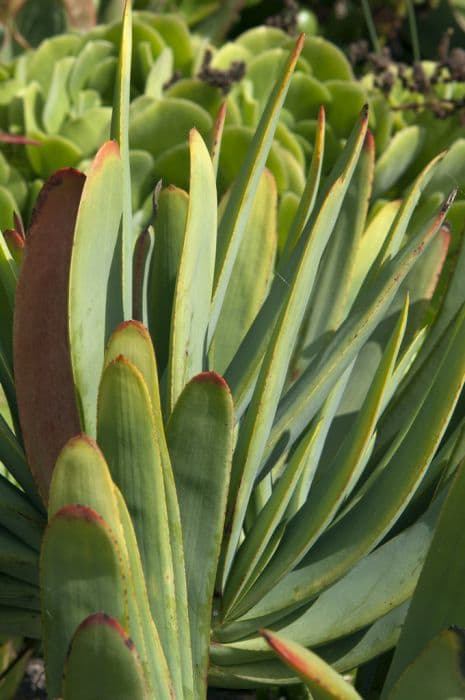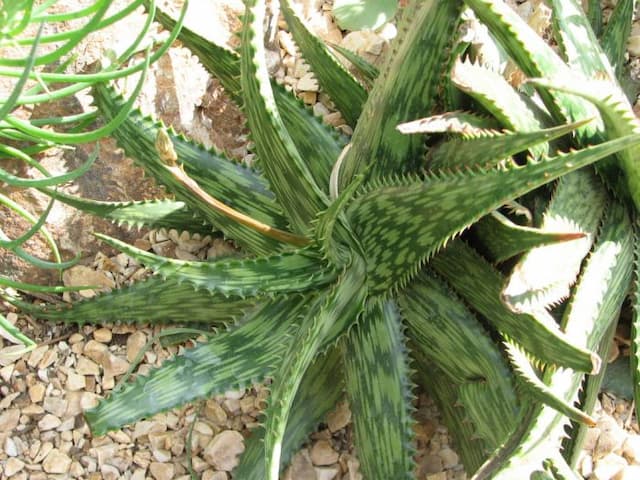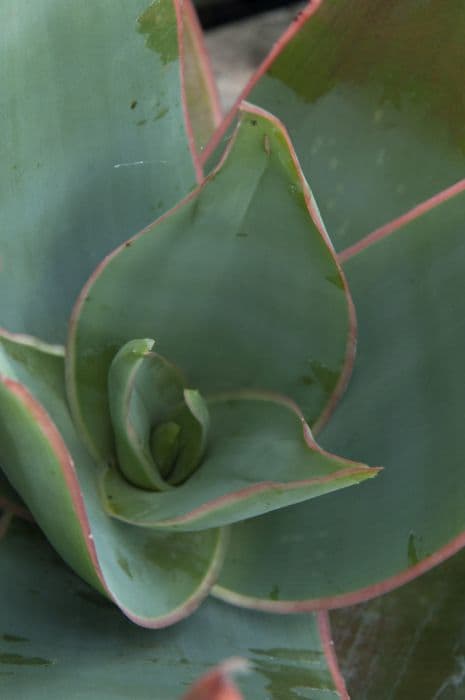Short-leaved Aloe Aloe brevifolia

ABOUT
Aloe brevifolia, commonly known as Short-leaved Aloe, is a succulent plant with a distinct appearance. The plant has a rosette formation of dense, blue-green leaves that are fleshy and filled with a gel-like substance. The edges of the leaves are adorned with small white teeth, which give them a slightly serrated look. As the plant matures, older rosettes will produce offsets, leading to a clump formation. The Short-leaved Aloe's leaves are stubby and broad, tapering to a point, and they have a smooth, waxy surface that can reflect sunlight. During its blooming season, the plant produces tall flower stalks topped with tubular flowers that can be red, orange, or yellow, adding a vibrant contrast to the greenish-blue hue of its foliage.
About this plant
 Names
NamesFamily
Asphodelaceae.
Synonyms
Short-Leaved Aloe, Blue Dwarf Aloe, Kleinaalwyn, Pearl Aloe.
Common names
Aloe brevifolia
 Toxicity
ToxicityTo humans
Short-leaved Aloe (Aloe brevifolia) is generally not considered highly toxic to humans, but it can cause some negative health effects if ingested. The outer skin of the plant contains compounds known as anthraquinones, which are known for their laxative properties and can cause gastrointestinal issues such as diarrhea, abdominal cramps, and nausea. The inner gel is less likely to cause problems if used topically for skin issues, but even this should be used with caution due to the potential presence of aloin, which can also be irritating. It's important to avoid consuming any part of the plant, especially if you are pregnant or have a digestive disorder. If ingested in large amounts, it could potentially lead to dehydration and a decrease in potassium in the body.
To pets
Short-leaved Aloe (Aloe brevifolia) can be toxic to pets if ingested. Similar to its effects in humans, the compounds within the plant, such as saponins and anthraquinones, can cause gastrointestinal upset in pets. Symptoms of poisoning in pets may include vomiting, diarrhea, lethargy, and changes in urine color. Additionally, ingestion can lead to depression and anorexia in more severe cases. The severity of the symptoms usually corresponds to the amount of plant material ingested. It is advisable to keep this plant out of reach of pets and seek veterinary care if you suspect your pet has ingested any part of the plant.
 Characteristics
CharacteristicsLife cycle
Perennials
Foliage type
Evergreen
Color of leaves
Green
Flower color
Red
Height
1-2 feet (30-60 cm)
Spread
1-2 feet (30-60 cm)
Plant type
Succulent
Hardiness zones
9
Native area
South Africa
Benefits
 General Benefits
General Benefits- Easy to Grow - Aloe brevifolia is a hardy plant that requires minimal care, making it suitable for beginners.
- Drought Tolerant - This succulent is highly drought-resistant, requiring very little water once established.
- Attractive Appearance - With its rosettes of blue-green leaves edged with small teeth, it adds aesthetic appeal to any garden or indoor space.
- Compact Size - Its small size makes it perfect for container gardening or small areas where space is limited.
- Low Maintenance - Aloe brevifolia does not require frequent feeding or pruning, saving time and effort for gardeners.
- Pest Resistant - This plant is generally resistant to pests, reducing the need for chemical insecticides.
 Medical Properties
Medical Properties- Skin Healing: Aloe brevifolia may contain compounds similar to those found in Aloe vera, which are known to help soothe and heal skin afflictions like burns, scrapes, and cuts.
- Anti-inflammatory: It might have anti-inflammatory properties that help reduce skin inflammation when applied topically.
- Moisturizing: The gel extracted from Aloe brevifolia leaves could potentially be used as a moisturizer to hydrate and soothe dry skin.
- Antimicrobial: There is a possibility that the plant has antimicrobial effects, which could help in preventing or treating infections when applied to the skin.
 Air-purifying Qualities
Air-purifying QualitiesThis plant is not specifically known for air purifying qualities.
 Other Uses
Other Uses- Aloe brevifolia, commonly known as Short-leaved Aloe, can be used in miniature gardens due to its small size and attractive rosette shape, to add a touch of greenery without overwhelming the space.
- Short-leaved Aloe's thick leaves have been used as a natural insulating material in small, traditional handcrafted items such as trivets or pot stands to protect surfaces from heat.
- The sap of Short-leaved Aloe can be applied to fishing lines made of natural materials, as it might prolong the durability by providing moisture resistance.
- In craft, the spiky leaves of Short-leaved Aloe can be used as natural stamps for creating patterns on fabrics or paper when dipped in paint or ink.
- The uniform pattern of Short-leaved Aloe's rosettes can be utilized as a natural model for teaching fractal geometry and patterns in nature in educational settings.
- Short-leaved Aloe can be used for practicing macro photography skills, as its intricate details and textures provide a good subject for close-up shots.
- The Short-leaved Aloe can act as a living barrier or natural fencing in gardens when planted in a continuous row, deterring small animals due to its pointed leaves.
- Dried Short-leaved Aloe leaves can be used in floral arrangements or as part of dried herb bouquets for their unique shape and texture.
- Short-leaved Aloe can serve as a natural dye plant, where the yellowish substance in the leaves might be used to dye fabrics or fibers.
- Due to its strong and rigid structure, Short-leaved Aloe can be included in outdoor model landscapes and train sets as a low maintenance, life-like miniature tree.
Interesting Facts
 Feng Shui
Feng ShuiThe Short-leaved Aloe is not used in Feng Shui practice.
 Zodiac Sign Compitability
Zodiac Sign CompitabilityThe Short-leaved Aloe is not used in astrology practice.
 Plant Symbolism
Plant Symbolism- Healing and Soothing: Aloe brevifolia, more commonly known as Short-leaved Aloe, is renowned for its therapeutic properties, especially in skincare and healing of burns or wounds.
- Protection: This plant is believed to offer protection, as its resilience and hardy nature can symbolize the ability to shield one from negativity or harm.
- Patience and Perseverance: With its slow growth and capacity to withstand harsh conditions, the Short-leaved Aloe represents the qualities of patience and perseverance.
- Endurance: Due to its succulent nature and ability to survive with minimal water, this plant symbolizes endurance and the ability to thrive under difficult circumstances.
- Resilience: The Short-leaved Aloe can bounce back from tough situations, symbolizing resilience in the face of challenges.
- Beauty: Despite its rugged appearance when not in bloom, the Short-leaved Aloe can produce beautiful flowers, reminding us that there is beauty in resilience and toughness.
 Water
WaterShort-leaved aloe should be watered deeply but infrequently, allowing the soil to dry out completely between waterings. Typically, this means watering every two to three weeks during the active growing season in spring and summer, and even less often during the dormant season in fall and winter, perhaps once a month. It's best to water at the base of the plant, avoiding getting water on the leaves to prevent rot. Provide roughly 8-16 ounces of water for smaller pots or up to 2 gallons for larger pots each watering session, adjusting the amount according to the size of the plant and pot.
 Light
LightShort-leaved aloe thrives in bright, indirect light, making it well-suited for a sunny indoor spot or a shaded outdoor area. It can tolerate some direct sunlight but should be protected during the hottest part of the day to prevent leaf scorch. A southern or western exposure is ideal for providing the bright light conditions that the short-leaved aloe needs to flourish.
 Temperature
TemperatureShort-leaved aloe prefers temperatures between 60 and 75 degrees Fahrenheit but can withstand occasional dips down to 40 degrees Fahrenheit and up to 80 degrees Fahrenheit. It is not frost-hardy and should be brought indoors or protected if outdoor temperatures fall below the minimum range. The ideal temperature range ensures healthy growth and flowering.
 Pruning
PruningPruning short-leaved aloe is usually done to remove damaged or dead leaves and to maintain its compact shape. Prune as needed, usually once a year, and perform any substantial pruning in the spring or early summer at the start of the growing season. Always use clean, sharp tools to make precise cuts and minimize damage to the plant.
 Cleaning
CleaningAs needed
 Soil
SoilThe best soil mix for Short-leaved Aloe is one that is well-draining and gritty, typically composed of a cactus potting mix combined with perlite or coarse sand to increase drainage. The ideal pH range for Short-leaved Aloe is between 6.0 and 8.0.
 Repotting
RepottingShort-leaved Aloe should be repotted every two to three years or when it outgrows its current container. It is a slow-growing succulent and doesn't require frequent repotting.
 Humidity & Misting
Humidity & MistingShort-leaved Aloe prefers low humidity conditions, typical of arid environments. The best humidity level for this plant is between 40% to 60%.
 Suitable locations
Suitable locationsIndoor
Place Short-leaved Aloe in bright, indirect light indoors.
Outdoor
In a sunny spot, protect Short-leaved Aloe from harsh midday sun.
Hardiness zone
9-11 USDA
 Life cycle
Life cycleThe life of Aloe brevifolia, commonly known as Short-leaved Aloe, begins with seed germination, where environmental conditions such as light, temperature, and moisture trigger the growth of a new plant from a seed. The seedling stage follows, characterized by the emergence of the first roots and leaves as the plant develops the ability to photosynthesize. As the plant enters the juvenile stage, it develops a rosette of fleshy, triangular leaves and a strong root system. The mature stage is reached when the Short-leaved Aloe is capable of reproduction, typically marked by the emergence of a flower stalk bearing tubular, orange-red flowers that attract pollinators. After pollination, seeds are produced and dispersed, completing the reproductive cycle. Over time, the mature plant may also produce offsets or "pups" from the base, contributing to vegetative propagation and the spread of the species.
 Propogation
PropogationPropogation time
Spring-Early Summer
Aloe brevifolia, commonly known as the Short-leaved Aloe, can be propagated effectively using offsets, which are small rosettes that form at the base of the parent plant. The best time for propagation is in the spring or early summer as this gives the plant plenty of time to establish itself during the growing season. When the offsets have formed a decent size, usually a couple of inches across, they can be carefully removed by gently pulling them apart from the main plant or slicing them off with a clean, sharp knife. Once removed, allow the cut surface on the offset to callous over for a day or two to prevent rotting. The offset can then be planted in a pot filled with a well-draining cactus or succulent potting mix, slightly moistening the soil. It's important to give the new plant a warm, bright spot out of direct sunlight until it establishes a strong root system, which typically takes a few weeks. After the plant is well-rooted, it can be transitioned to brighter light.









